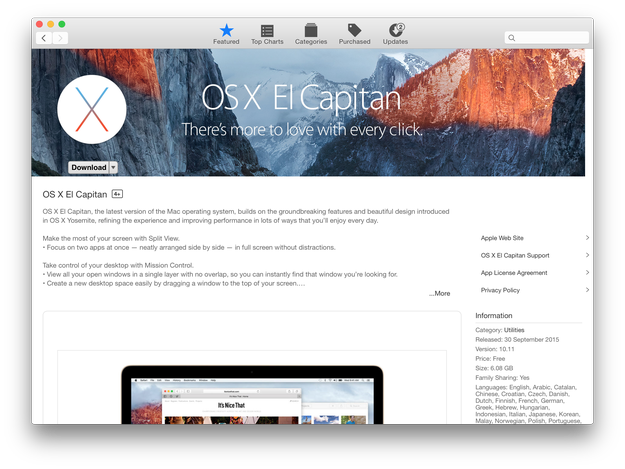There are two recommended installation methods for El Capitan download and install on your Mac PC or Laptop recommended by the Apple. Before use those installation methods you should need to have free space (around 12 GB) on your drive for keeping the installation files when installation is processing. If you do not have free space available on your drive, please use some cleaning software to clean up the drive to remove junk files and unnecessary application data and folders from the drive.
Then you must keep a backup of your previous file, folders, and applications before upgrading the El Capitan download installation. You can use a clone backup tool for backing up your Mac PC or laptop.
On a Mac that is compatible with El Capitan, open the disk image and run the installer within, named. You will create the bootable installer from this. Download OS X El Capitan from Apple Server and install it on your Mac. Get El Capitan DMG for Bootable Installer. Download El Capitan without the App Store.
:max_bytes(150000):strip_icc()/CreateBootableElCap-56a5d54d3df78cf7728a1052.jpg)
Install El Capitan Download On Empty Volume
In this method, you will be installing the Mac OS X El Capitan on an empty drive. The volume doesn’t have any files, folders or applications. There is no any startup volume on your PC when you are going to clean install El Capitan. So you can easily use the El Capitan installer to install the OS X into the clean empty volume.

Install El Capitan On The Startup Volume
In this method, you will be installing the OS X on your existing startup volume. Here you need to keep a backup of your data stored on the existing startup volume. For install the El Capitan on your startup volume, you need to create a bootable USB installer on a separate drive (USB pen drive).
Keep A Backup For El Capitan Download Before Installing.
You need to choose a good backup tool for backing up the existing OS’ files, folders, and applications. There are many tools and applications available on the internet for backing up the Mac OS X El Capitan download.
You can check whether the created bootable drive is working properly by checking system preferences and selecting the startup disk pane and booting the backed up drive.
How To Create A Bootable Installer To Install El Capitan Download
Apple Mac Apps store allows you to El Capitan installer directly. All you need to do is navigate through the Mac Apps store and find the appropriate link to El Capitan download. Next, you need to do is to create a bootable USB installer. Before you do this step please keep more than 12 GB of free volume space to create the bootable USB installer.
Then Follow The Steps That Mentioned Below.


First of all, you need to plug in the USB drive to your Mac PC or laptop. Here you should use a second internal volume for installing the files. Then open the terminal by searching the search bar and type the command createinstallmedia and enter. As soon as you enter the above command, the system will identify the USB drive which is plug in on it. After the recognizing, the system will begin to store the El Capitan installer files on the USB. After a few minutes, the system creates a bootable USB drive that has the El Capitan installer.

Enter the following path to the terminal
/Applications/Install OS X El Capitan.app/Contents/Resources/createinstallmediaEl Capitan Iso File
Here the El Capitan installer must be in the application folder to do this step.
Demo: -
In this example, the El Capitan installer in the application folder and Myusb is the name of USB drive which is used to boot.
sudo /Applications/Install OS X El Capitan.app/Contents/Resources/createinstallmedia --volume /Volumes/MyVolume --applicationpath /Applications/Install OS X El Capitan.appEl Capitan Compatible Devices
iMac, Mac Book, 13 inch Mac Book Pro, Mac Book Retina Models, 17 inch Mac Book Pro, Mac Book Black and White, Xserve – 2009, 15 inch Mac Book Pro, Mac Mini, Mac Book Air, Mac Pro
El Capitan Os X Download
System Requirements For El Capitan Download
OS X v10.6.8 or later, 2GB memory, 8.8GB storage